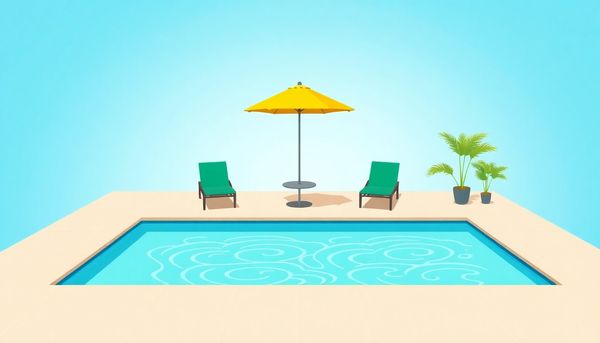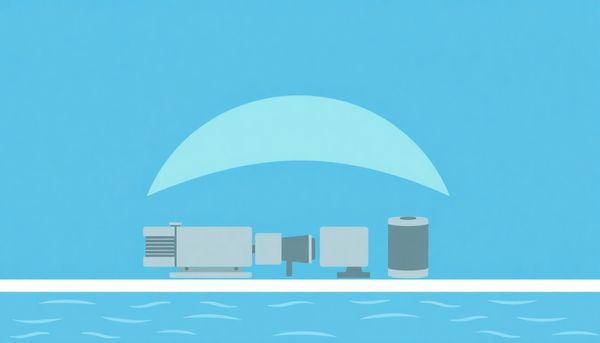Explore the Advantages of Modern Salt Water Pool Systems
August 30th, 2024
August 30th, 2024
Stepping into the world of salt water pool systems can feel like discovering a hidden gem in the realm of modern home amenities. I remember chatting with a friend who recently transitioned from a traditional chlorine pool to a salt water system. Her enthusiasm was contagious as she extolled the virtues of softer water that left her skin feeling smooth, not to mention the reduced chemical smell. As more pool owners share similar stories, it's no surprise that interest in salt water systems is on the rise.
These systems, often misunderstood, offer a different approach to pool maintenance by using a salt chlorine generator. This device transforms dissolved salt into chlorine gas, keeping the pool free from algae and bacteria, while creating a more pleasant swimming experience. Instead of the harsh, stinging sensations often associated with traditional chlorine pools, users report a gentler, spa-like environment.
For those considering the switch, several factors come into play, such as initial costs, maintenance requirements, and environmental impact. It's important to weigh these alongside the benefits to determine if a salt water pool system aligns with your lifestyle and budget. Whether you’ve just acquired a backyard oasis or are contemplating an upgrade, understanding these systems can lead to a choice that enhances your swimming experience, offering comfort and convenience in equal measure.

Selecting the right salt water system for your pool can feel like choosing the perfect partner: it's about compatibility, reliability, and long-term benefits. When I first ventured into the salt water pool realm, I found myself overwhelmed by the myriad of options. Each system promised crystal-clear water with minimal fuss, but the details mattered.
Firstly, consider the size of your pool. Larger pools might benefit greatly from robust systems like the Hayward Salt Chlorination System, known for its longevity and comprehensive control over chlorine levels. Its self-cleaning feature is akin to having a little helper, reducing the manual labor typically associated with pool maintenance. For those dealing with space constraints, the Pentair IntelliChlor stands out. This compact unit whispers efficiency, adapting to tighter setups without compromising on performance, though its replacement parts do carry a steeper price tag.
Then there's budget-friendly options for more modest pool sizes, such as the Krystal Clear Intex Salt Water System. It’s an ideal pick for above-ground pools, marrying functionality with affordability. However, it's crucial to verify compatibility with your current pool setup, as its parts may not be readily available.
Ultimately, prioritize reputable brands and systems with a solid warranty. Regular maintenance, like replacing the salt cell every few years, is essential for longevity. Remember, the right system not only fits your pool but also your lifestyle, allowing you to enjoy your personal oasis without unnecessary hassle.
When contemplating the switch to a salt water pool system, the layout of your pool area and the compatibility of the equipment with your current setup are crucial considerations. It's like rearranging furniture in a room; the perfect sofa can make or break the space. Similarly, a salt water system must fit seamlessly into your pool’s architecture to function efficiently.
First, evaluate the physical space available for the system. Some salt water generators, like the Hayward Salt Chlorination System, demand more room but offer unmatched durability and ease of use. If you’re working with compact space, the Pentair IntelliChlor could be your knight in shining armor, offering a sleek design ideal for tighter setups, albeit with a potential trade-off in replacement costs.
Beyond physical dimensions, the system's compatibility with existing plumbing and electrical configurations is equally important. Weigh the specifications of each potential unit against your current setup to avoid costly modifications. A mismatched system can lead to inefficient chlorine production or even damage to pool components.
Moreover, consider future maintenance. Salt water systems require periodic salt cell replacements, and ensuring that compatible parts are readily available is key. This foresight not only reduces long-term operational headaches but also extends the life of your investment, making the initial choice all the more strategic. Ultimately, a well-suited salt water pool system is as much about fitting your current needs as it is about planning for the future.
Transforming a pool from traditional chlorine to a salt water system involves more than just a simple swap. Salt water systems boast the allure of reduced chemical handling and a consistent chlorine supply, but an in-depth evaluation of maintenance and cost is essential before diving in.
Owning a salt water pool system, like the Hayward Salt Chlorination System or Pentair IntelliChlor, requires an upfront investment ranging from $1,000 to $2,500. This price tag includes the unit and installation, but additional costs come into play with the salt cell, which needs replacing roughly every five years at several hundred dollars. While this might seem daunting, many pool owners find financial relief in the long term; salt is significantly cheaper than chlorine, and the system automates chlorination, reducing time and effort spent on pool maintenance.
However, one must account for potential hidden costs. Increased electricity usage accompanies running a salt water generator, adding around $40 to $50 annually to utility bills. Furthermore, salt can be corrosive. Regular inspections and maintenance of metal fixtures, heaters, and poolside furniture are necessary to prevent damage.
Salt water systems streamline pool care, offering a more hands-off approach and reducing the chemical smell that often plagues traditional setups. Yet, they demand careful consideration of both upfront and ongoing expenses to determine if their benefits align with personal priorities and budget constraints.
Navigating the myriad of salt water pool systems can feel like exploring an intricate tapestry of options, each offering unique benefits and quirks. From compact designs to high-capacity powerhouses, understanding your choices can transform your pool maintenance routine into a seamless experience. As someone who once spent countless weekends wrestling with chlorine tablets, I can attest to the relief of switching to a salt water system.
Begin your exploration with the Hayward Salt Chlorination System, renowned for its durability and ease of use. This system's long lifespan and customizable chlorine output allow for precise control, reducing the time you spend fretting over chemical balances. Its high/low salt and temperature indicators safeguard your equipment, while the self-cleaning salt cell simplifies maintenance tasks. Whether your pool is nestled in-ground or floats above, Hayward offers models to fit.
For those with limited space, the Pentair IntelliChlor is a compact yet efficient alternative. Its neat design integrates easily into tight plumbing setups, and its user-friendly display keeps you informed about salt levels and water quality. However, keep in mind the higher cost of replacement parts, an investment for its versatility and reliable performance.
If budget constraints or smaller pool sizes are considerations, the Krystal Clear Intex Salt Water System might be the right fit. Designed for above-ground pools, it offers affordability without compromising functionality. It connects effortlessly to existing Intex systems, although adapters may be needed for other setups. Remember, regardless of brand, ensure your chosen system aligns with your pool's specifications to enjoy uninterrupted aquatic bliss.

Selecting the right salt water generator can feel like navigating a maze of choices, each with its own perks and drawbacks. As you sift through options, think of the Hayward Salt Chlorination System as the seasoned veteran of the group. It boasts a robust lifespan and provides the user complete control over chlorine levels, making it an ideal choice for those with larger inground pools. Its high/low salt and temperature indicators will keep your equipment safe and sound, while the self-cleaning salt cell takes the hassle out of maintenance.
For those grappling with limited space, the Pentair IntelliChlor steps in as a more compact contender. Its petite frame fits snugly into cramped pool setups without sacrificing functionality. Just be mindful that its all-in-one design means pricier replacement cells, so budget accordingly. This system suits a variety of pool sizes, handling everything from modest 20,000-gallon pools to more massive 60,000-gallon stretches of water.
On the other hand, if budget constraints are top of mind and your pool is smaller, the Intex Krystal Clear Salt Water System might catch your eye. Tailored for above ground pools up to 15,000 gallons, it’s both affordable and easy to install. But remember, finding replacement parts can sometimes be a slight challenge, and a compatible pump with at least 700 GPH is required.
Navigating these options, consider your pool size, available space, and long-term maintenance needs. Each system offers unique advantages, so aligning them with your specific requirements ensures a splash-worthy investment.
Before embracing the world of salt water pool systems, it's crucial to scrutinize the installation requirements. Each backyard oasis presents its own set of challenges, and understanding these can save you time and frustration. For instance, consider your pool's existing plumbing setup. Some systems, like the Hayward Salt Chlorination System, demand a bit more space. This might not be a big deal if you've got room to spare, but if your pool area is compact, the Pentair IntelliChlor, known for its smaller footprint, could be a more suitable fit.
It's not just about space, though. Compatibility with your pool's existing equipment plays a pivotal role. If your pool is already equipped with a high-efficiency pump and filter, you'll want to ensure that the salt system aligns seamlessly with them. The Intex Krystal Clear Salt Water System is a favorite among above-ground pool owners, particularly those with Intex setups, due to its simple installation process. However, remember that new adapters might be necessary if you're venturing beyond the Intex family.
Moreover, electrical considerations shouldn't be overlooked. Salt water generators require a reliable power source, so check if additional electrical work is necessary. This might add to the initial investment but ensures a smooth operation in the long run. Lastly, keep in mind the local climate; salt water systems have temperature thresholds, and regions with extreme temperatures may require more robust equipment to withstand these conditions. Balancing all these factors will guide you to the perfect salt water system for your aquatic retreat.
Understanding the maintenance needs of a salt water pool system is essential before taking the plunge. These systems, although efficient, demand attention to both equipment and water chemistry. Regular upkeep ensures that your investment serves you well over the years.
First and foremost, the salt cell, the heart of your system, requires periodic inspection and cleaning. Depending on the model, self-cleaning features like those found in some Hayward systems can ease this task, but it's still wise to check for calcium build-up. Regularly monitoring salt levels is crucial, too. Most systems operate optimally at around 3,000 parts per million (PPM), similar to the salinity of human tears. Too high or too low levels can affect performance and potentially harm the cell.
Moreover, while salt water systems reduce the need for manual chlorine handling, they do rely on electricity. Keep an eye on the generator's power consumption and ensure your system runs efficiently to avoid unnecessary spikes in energy bills.
Corrosion is another aspect worth considering, especially if you have metal components in or around your pool area. Salt can be harsh on metals over time, leading to potential repairs or replacements. Thus, regular inspections of ladders, light fixtures, and other metal parts can prevent long-term damage.
In summary, a salt water pool system can simplify your pool care routine, but it doesn’t eliminate maintenance altogether. With regular checks and balances, your pool will remain a refreshing haven for years to come.
Understanding the lifespan of salt water pool systems is crucial when weighing up their value. I've got a friend, Mike, who switched from a traditional chlorine pool to a salt water system a few years back. He often mentions how the longevity of these systems played a significant role in his decision. If you're fed up with the constant chore of chlorine management, knowing what to expect in terms of durability can guide you in making an informed decision.
Hayward Salt Chlorination Systems are celebrated for their robust build, often outlasting competitors. With a lifespan averaging five to seven years for their salt cells, they offer users a longer period of hassle-free operation, reducing the frequency of replacements. Meanwhile, Pentair IntelliChlor systems, though compact and convenient, might hit your wallet harder due to costlier replacement parts. This is something to consider if long-term maintenance is a concern.
For those with smaller, above-ground pools, the Intex Krystal Clear Salt Water System presents a more economical choice. However, the trade-off comes with its limitations on part availability, which could shorten the system's effective life if components are hard to find. Each system has its strengths and weaknesses, but investing in a reputable brand with a solid warranty can ensure you get the most out of your salt water pool system over the years.

Maintaining a pool often sounds like a chore that's best left to professionals, but what if there were a way to simplify the task without sacrificing water quality? Enter salt water pool systems—a game changer for those seeking a hands-off approach to pool care. Unlike traditional chlorine pools, salt water setups minimize the need for frequent chemical handling and constant monitoring. Picture a lazy afternoon by the pool without the lingering scent of chlorine or the worry of adjusting chemical levels.
Switching to a salt water system shifts the complexity of maintenance from daily tasks to occasional check-ups. These systems use salt to generate chlorine naturally, offering a consistent sanitation process. The beauty of this system lies in its automation; the salt water generator handles the chemistry, leaving you with less to fuss over. Yet, it's not just about ease—it's about the experience. Swimmers often find salt water pools gentler on the skin and eyes, thanks to the reduced chloramine levels.
Further reducing your workload, models like the Hayward Salt Chlorination System feature self-cleaning cells and intuitive controls, ensuring longevity and user-friendliness. While the initial investment is notable, think of the time saved and the reduction in annual chemical costs. For those tired of the traditional chlorine routine, a salt water system isn't just a convenience; it’s an invitation to enjoy your pool the way it was meant to be—effortlessly.
Choosing the right salt system for your pool is a bit like selecting the perfect pair of shoes—it's all about fit, durability, and comfort. First, consider the size and type of your pool. Larger pools, especially inground ones, might benefit from the robust Hayward Salt Chlorination System, renowned for its longevity and ease of use. This model offers customizable chlorine output and integrates seamlessly with most pool automation systems. However, it's essential to ensure you have ample space for its installation.
For those with space constraints or intricate plumbing setups, the Pentair IntelliChlor presents a compact and versatile alternative. It’s suitable for various pool sizes and features a user-friendly display for easy monitoring. Remember, though, its replacement parts are a bit pricier, which could affect your budget down the line.
If you're managing a smaller above-ground pool and have cost in mind, the Intex Krystal Clear Salt Water System might be your best bet. It’s budget-friendly and straightforward to install, making it a popular choice among pool owners looking to avoid complex setups.
No matter which system you select, it's crucial to purchase from a reputable brand with a solid warranty. Doing so ensures the availability of replacement parts for years to come. Lastly, double-check compatibility with your existing pool and plumbing setup to avoid any inconvenient surprises.
Embarking on the salt water pool journey requires more than just a simple switch of systems. The initial installation of a salt water chlorinator can seem daunting, but with thoughtful planning and attention to detail, it transforms into a manageable task. Many pool owners, myself included, find that the Hayward Salt Chlorination System offers an intuitive setup process. Its digital displays make it straightforward to adjust chlorine levels, ensuring you maintain that perfect balance effortlessly. A friend of mine, skeptical at first, was pleasantly surprised by how seamlessly it integrated into his existing setup, making the transition smoother than he anticipated.
To ensure your system runs like a well-oiled machine, regular maintenance is crucial. Thankfully, systems such as the Hayward come equipped with self-cleaning salt cells. This feature significantly reduces the time spent on upkeep, allowing you more leisure in your pool rather than laboring over it. However, it’s wise to routinely check and clean the cell manually to preempt any potential buildup that might affect performance.
For those navigating tight spaces or smaller pools, the Pentair IntelliChlor presents a compact alternative. Its modular models cater to various pool sizes, offering flexibility, but remember to budget for its pricier replacement parts. Regardless of the system chosen, purchasing from reputable brands with solid warranties ensures peace of mind. This proactive approach in installation and maintenance not only extends the life of your investment but also maximizes enjoyment of your salt water oasis.
Chlorine production is the heartbeat of any salt water pool system, and optimizing it can lead to crystal-clear water with minimal effort. When I first considered transitioning to a salt water system, the idea of consistent chlorine levels while reducing manual chemical handling was appealing. But achieving this balance requires an understanding of how to optimize your system effectively.
First, ensure your salt water generator is appropriately sized for your pool. An undersized unit will struggle to maintain proper chlorine levels, while an oversized one could lead to unnecessary wear. For instance, if you're using a Hayward system, it’s crucial to match the model to your pool's gallon capacity. Additionally, maintaining the ideal salt concentration is key. Aim for 3,000 parts per million (PPM) to keep the generator functioning efficiently. Too little salt, and the system can't produce enough chlorine; too much, and you're risking equipment corrosion.
Regular maintenance, such as cleaning the cell and checking for deposits, enhances the longevity of your system. My own routine involves monthly checks to ensure optimal performance. Pairing this with the system's self-cleaning feature, like those found in many Hayward models, means less manual intervention and more time enjoying the pool.
Lastly, utilize the system’s digital settings to fine-tune chlorine output, responding to changes in weather, pool usage, and water temperature. With these adjustments, you'll keep your chlorine levels steady, ensuring a refreshing swim experience while minimizing potential irritations.

For anyone weary of the constant chlorine juggle, salt water pool systems present a refreshing alternative. They simplify the chemical maintenance routine, allowing you to focus on enjoying your pool rather than serving as a weekend chemist. Gone are the days of measuring out chlorine granules or wrestling with liquid chlorine bottles. Instead, a salt water pool uses a generator to transform ordinary pool-grade salt into chlorine, meticulously maintaining optimal levels without your intervention.
Reflecting on personal experiences with conventional chlorine pools, the shift to a salt water system feels like a breath of fresh air. Imagine lounging by the pool with the assurance that your water is consistently sanitized, free from the harsh chlorine scent and with reduced skin and eye irritation. This is one of the understated joys of a salt water system: the elimination of fluctuating chlorine levels that can lead to pesky algae or cloudy water.
Investing in a reliable salt water chlorinator, like the Hayward Salt Chlorination System, can make pool care more manageable. This option offers users an extended lifespan and the ability to adjust chlorine levels effortlessly. Not to mention, the technology behind these systems typically includes self-cleaning features, adding another layer of convenience.
While there's an initial cost to consider, the long-term savings on chlorine purchases and the reduction in maintenance hassle make salt water systems a worthy consideration. It's a shift that promotes more pool time and less pool upkeep, ultimately enhancing your swimming experience.
Navigating the world of salt water pool systems can feel like wandering through a maze of choices, each promising crystal-clear perfection. To find your perfect match, consider your pool's unique personality and your lifestyle needs. First, assess the size of your pool. For larger inground setups, the Hayward Salt Chlorination System stands out with its robust durability and ease of use. Its digital display and compatibility with pool automation systems provide a user-friendly experience, making it a top pick for tech-savvy pool owners.
Space constraints might nudge you towards the Pentair IntelliChlor, a more compact alternative. This system is ideal for snug installations and offers a flexible range of models catering to various pool sizes. Its all-in-one design could stretch your budget on replacement parts, but the trade-off is a streamlined, efficient chlorine output.
For those with smaller, above-ground pools, the Intex Krystal Clear Salt Water System delivers affordability without sacrificing functionality. Its straightforward setup and programmable timer make it a practical choice, though finding replacement parts might require some extra effort.
Ultimately, the best salt water system is one that aligns with your pool's specifications and your maintenance style. Prioritize products from reputable brands with comprehensive warranties to ensure peace of mind. As you weigh your options, consider future-proofing your purchase by checking for compatibility with existing pool setups and availability of replacement parts. This thoughtful approach will not only safeguard your investment but also enhance your pool enjoyment for years to come.
In the world of pool maintenance, the hidden gem of a salt water system often glimmers not just for its ease, but for its cost-saving prowess. Transitioning from traditional chlorine pools to a salt water system can initially seem like a hefty expense, yet the financial benefits unfold over time like a well-kept secret. When we swapped our chlorine pool for a salt water system last summer, the upfront cost felt daunting. However, the long-term savings became evident as the months went by.
Primarily, the reduction in chemical purchase is significant. Traditional pools demand a constant supply of chlorine, whereas a salt water system only requires an initial investment in salt, and occasional replenishment. This change alone can cut chemical costs by half or more annually. In practical terms, for a pool owner like me, this meant channeling funds previously earmarked for chlorine to other home improvements.
Moreover, maintenance takes on a new simplicity. The consistent chlorine generation by the salt water chlorinator reduces the need for frequent water testing and adjustments. This not only saves money on testing kits and corrective chemicals but also slashes the time spent on pool upkeep. Imagine reclaiming hours each month from pool maintenance, which can now be spent enjoying a swim or hosting a barbecue beside the glistening water.
Ultimately, while the initial investment may cause a pause, the ongoing savings in chemicals, time, and maintenance make salt water systems a choice well worth considering.
Securing a salt water pool system's smooth operation begins with its meticulous installation and diligent maintenance. When my friend transitioned his backyard oasis to a salt water system, the difference was night and day—no more bleached swimsuits or chlorine smell. Yet, this transformation started with careful installation. Ensuring the salt water chlorinator is compatible with your pool’s plumbing is crucial. Before you dive into the installation process, consult with a professional or refer to the manufacturer's guidelines. This step is pivotal to prevent any mishaps, such as leaks or inadequate chlorine production.
Regular maintenance follows installation, safeguarding your investment's longevity. A handful of routine checks can make all the difference. For instance, regularly inspect the salt cell for scale build-up, a common occurrence that can impede the system’s efficiency. A gentle rinse with a diluted acid solution can keep it in prime condition. Moreover, consistently monitor the salt levels in your pool. A friend once ignored his pool's salinity, leading to erratic chlorine levels and a cloudy pool—a simple oversight with frustrating consequences.
Finally, don't forget about your system’s companion components. Elements like pumps and filters also need attention, as salt can be subtly corrosive over time. Investing in quality parts and occasionally enlisting professional maintenance can extend the life of your entire setup. Just like any other piece of machinery, a little care and attention go a long way towards ensuring your salt water pool remains a pristine retreat.

Salt water pools offer convenience and a steady chlorine supply, but they come with a caveat: the potential for salt to damage equipment. The challenge lies in the corrosive nature of salt, which can quietly erode metal fixtures, pool lights, heaters, and more, if not properly managed. Imagine investing in a state-of-the-art salt system, only to find rust spots on your pool ladder a few months down the line. A little foresight can save unnecessary stress and expense.
First, consider regular inspections of your pool equipment. Look for early signs of corrosion, particularly in metal parts. Coating metal fixtures with a protective sealant can act as a barrier against salt damage. Some pool owners also opt for equipment made from corrosion-resistant materials, such as titanium, which can withstand the effects of salt better than traditional metals.
Additionally, monitoring salt levels is crucial. A system like the Hayward Salt Chlorination System, with its high/low salt indicators, helps ensure your pool isn't operating with excessive salinity, which can accelerate wear and tear. A small investment in a quality test kit can also keep your salt levels in check, preventing potential equipment degradation.
Lastly, rinse off any salt residue on pool surfaces and nearby equipment. Simple garden hose sprays can wash away salt deposits, reducing the corrosive impact. By taking these preventive steps, you can enjoy the benefits of a salt water pool without unwelcome surprises.
When considering a salt water pool system, the significance of choosing a reputable brand cannot be overstated. My neighbor, who recently ventured into the world of salt water pools, learned this the hard way. They initially opted for a cheaper, lesser-known brand, only to find themselves struggling with frequent malfunctions and scarce replacement parts. Eventually, they switched to a Hayward system, which, despite its higher upfront cost, offered peace of mind with its reliability and readily available customer support.
Reputable systems, like those from Hayward and Pentair, are not just about brand prestige. They are meticulously designed for durability and efficiency, offering features such as self-cleaning salt cells, which ease maintenance and extend the life of the unit. These brands also come with robust warranties, typically up to three years, ensuring that you are covered for any unforeseen issues. This is crucial, considering that a salt cell replacement is a significant investment you'll face every 5 to 7 years.
Furthermore, choosing a trustworthy brand means you'll have access to replacement parts and professional support when needed. This is especially important if your pool has unique features or setup requirements. In the end, investing in a well-regarded salt water system is not just about the convenience of chlorine management; it’s about ensuring your pool remains an enjoyable and hassle-free retreat for years to come.
Maintaining the perfect salt balance in your salt water pool isn't just a task, it's an art form. Too little salt, and your generator can’t produce enough chlorine; too much, and you risk corrosion and irritation. Let’s talk about keeping that balance just right.
Salt levels in your pool should ideally hover around 3,000 parts per million (PPM). This isn’t just a random number; it’s the sweet spot for efficient chlorine production without leaving your pool feeling like a day at the beach. Regularly testing your pool water is crucial. A digital salinity tester can be your best friend here, providing accurate readings with ease. If you’re old school, test strips are a reliable backup, though they may not be as precise.
When it comes to adding salt, remember less is more. Start small and gradually work your way up to the desired level. Take it from my experience: once I dumped in an extra bag thinking it would speed things up. I ended up with a pool that tasted like a salt shaker — not fun, and quite a task to rectify.
And don’t forget about the weather. Heavy rainfall can dilute salt levels, while water evaporation might concentrate them. Keeping an eye on these natural elements can save you from unexpected shifts.
Ultimately, by maintaining the right salt levels, you're ensuring not just the longevity of your pool equipment but also the comfort and enjoyment of every swim.

This article provided insights into maintaining your pool. Start your pool care journey today!
Want to become a pool maintenance expert? Our free Pool School course covers everything you need to know about pool care. From basic maintenance to advanced troubleshooting, you'll learn how to:
Join over 10,000 pool owners who have already transformed their pool care routine. Get started with our free Pool School course today!